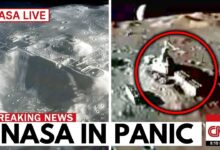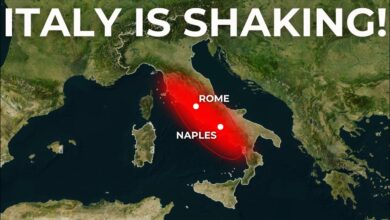Voyager 1 Just Detected A TERRIFYING Object In Space!

NASA recently announced that its Voyager 1 probe, the farthest human-made object in the universe, is once again sending usable data back to Earth—over 45 years after its launch. Voyager 1, a pioneering spacecraft, continues to relay groundbreaking information from interstellar space, an uncharted territory beyond our solar system. While its discoveries have always been remarkable, a recent transmission has left scientists both fascinated and perplexed.
As Voyager 1 crossed the heliopause—the boundary where the Sun’s influence ends and interstellar space begins—it detected something extraordinary. The probe picked up weak electromagnetic signals coming from an unknown object that doesn’t align with anything previously recorded in scientific models. Its size, shape, and nature remain a mystery, sparking intense curiosity and speculation.
This object appears to emit random energy waves originating from a single point. Unlike emissions from pulsars, quasars, or remnants of cosmic events like supernovae, the signals Voyager 1 detected do not match known celestial patterns. Even more intriguing, the object’s movements suggest it may interact with its surroundings in unexpected ways. Scientists are puzzled, as the electromagnetic waves also exhibit frequencies never before observed in interstellar space.
Theories about the object’s origins and composition abound. Some experts speculate it could be a form of strange matter that challenges the known laws of physics. Others suggest it might be a relic from the early universe, offering insights into how galaxies, stars, and planets first formed. A more speculative but fascinating idea proposes that the object could be evidence of extraterrestrial technology—a probe or artifact from an advanced civilization.

Voyager 1’s aging instruments, though groundbreaking for their time, limit the ability to fully analyze this mysterious object. At more than 14 billion miles away, communication with the spacecraft takes over 20 hours each way, complicating further study. Despite these challenges, scientists are using simulations and models to decode the data and determine the object’s nature.
This discovery underscores how little we know about interstellar space. Long thought to be largely empty, this region may harbor far more matter and phenomena than previously believed. If true, Voyager 1’s findings could reshape our understanding of cosmic structures and forces, including dark matter and energy.
The implications of this discovery are profound. Whether the object is a new type of matter, a fragment of the early universe, or even a product of intelligent design, it challenges current scientific knowledge and opens doors to new exploration. It also highlights the enduring legacy of the Voyager missions, which continue to push the boundaries of space exploration decades after their inception.

As humanity stands on the cusp of solving this cosmic riddle, Voyager 1’s findings remind us of the vastness of the universe and the many secrets it still holds. Future missions equipped with modern technology may one day uncover the truth about this mysterious object and what it means for our place in the cosmos. For now, the discovery serves as a humbling and awe-inspiring reminder of how much there is left to explore.
Humans have always aspired to be a species that can live and explore the stars. Although Voyager 1 has achieved many amazing things, it is still a lone explorer in the universe. To continue this journey, we must face challenges such as long-duration flights, interstellar dangers and the unknown in the dark of space.
This new discovery may force humans to rethink the concept of life and intelligence. It may not be a planet, a star, or even an alien creation, but something that surpasses our current understanding of life and exists on a cosmic scale. This could open up new research into different forms of life that humans have never thought of. For example, there may be life forms that thrive in extreme environments, far from the conditions we think are necessary for survival.
This discovery also highlights the importance of investing in space technology. Voyager 1 is an old probe that has exceeded all expectations. However, at some point, it will stop communicating with Earth. Therefore, new projects are needed to inherit and expand what Voyager 1 has done, helping us explore deeper into the vast universe. The next generation of probes will be equipped with more advanced technology, operate more durably and can travel farther and faster.

In the future, we may even deploy probes with artificial intelligence, helping them make decisions when exploring deep space. Even missions to bring samples from outside the Solar System back to Earth may become a reality. With current technology, humans have successfully collected samples from the Moon, Mars and comets, so this prospect is completely feasible.
In addition, Voyager 1’s discoveries also encourage international cooperation in space research. As the distances to explore increase, the tools and knowledge required become more complex, requiring many nations to pool resources and technology. In addition, the curiosity about the universe also attracts the interest of non-specialists, from amateur scientists to the general public.
One of the biggest changes from this discovery is the way we perceive interstellar space. Previously, scientists believed that interstellar space was mainly composed of cosmic radiation, dust and sparse gas. However, the objects discovered by Voyager 1 suggest that this space may be much more complex. It raises questions about the origin and nature of these objects: are they remnants of supernova explosions, or are they the result of unknown cosmic processes?
This discovery also improves our models of how matter and magnetic forces interact in interstellar space. These forces could play a role in the formation of larger cosmic structures such as nebulae or filaments of gas that connect galaxies. It is possible that the object is a cosmic “wanderer” – a celestial body that has been ejected from its star system and is now drifting through the galaxy. If so, studying it could help us better understand the distribution and role of these objects in the evolution of galaxies.
Another intriguing hypothesis is that the object could be related to dark matter – a component that makes up 27% of the universe but has never been directly observed. If this is indeed evidence of dark matter, it would open up opportunities to study one of the universe’s greatest mysteries.
Finally, Voyager 1’s discovery raises questions about intergalactic space – a region of space that is even less explored than interstellar space. If structures exist in this space, it could change the way we understand the connection between galaxies and the universe.
In short, Voyager 1’s discovery is just the beginning of a new journey. It reminds us of the wonder and mystery of the universe, and encourages humanity to continue exploring the far reaches of space.








